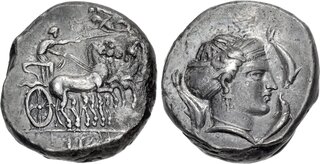| Classical Numismatic Group > Triton XXVII | Auction date: 9 January 2024 |
| Lot number: 103 Price realized: 2,500 USD (Approx. 2,290 EUR) Note: Prices do not include buyer's fees. | Show similar lots on CoinArchives Find similar lots in upcoming auctions on |
| Lot description: SICILY, Lilybaion (as 'Cape of Melkart'). Circa 350-310 BC. AR Tetradrachm (23mm, 17.28 g, 11h). Charioteer, holding kentron in extended right hand and reins in left, driving fast quadriga right; above, Nike flying left, crowning charioteer with open wreath held in both hands; [RŠ]MLQRT ("Raš Melqart" in Punic) in exergue / Head of female right, wearing sphendone, triple-pendant earring, and linear necklace; three dolphins swimming around. Jenkins, Punic 5 (O4/R4); CNP 315; HGC 2, 731; Boston MFA Supp. 24 = Jameson 1903 (same dies). Deeply toned, patches of find patina, some light scratches. Good VF. Very rare early type, and one of only two examples known with this die combination. From the L.H. Collection.. Lilybaion, modern day Marsala, was a Punic city in Sicily founded in the fourth century BC. The destruction of the chief Punic stronghold Motya in 397 BC by the Syracusan tyrant Dionysios I left the denizens of Motya without a home and Carthage without a primary military base on the island. In order to remedy both of these issues, the city of Lilybaion was founded by the survivors from Motya. The new port town would become a thriving trade hub and the most important military base in Sicily. The strong new walls that were built to defend the city were able to fend off both Pyrrhos of Epiros and the Romans. It was the last bastion of Punic rule in Sicily during Pyrrhos' conquest of the island, beating back his attempts to take the city before his campaign unraveled entirely. The Romans placed the city under a nine year siege with numerous assaults during the First Punic War, but they were never able to capture the city and only gained control of it after Carthage's surrender at the end of the war. The issue of tetradrachms that are purportedly from Lilybaion were all struck in the later half of the fourth century BC. While many show strong affinity for Syracusan styles from the same period, Jenkins notes that this series relies heavily on prototypes from the Entella series. Estimate: 2000 USD |  |



